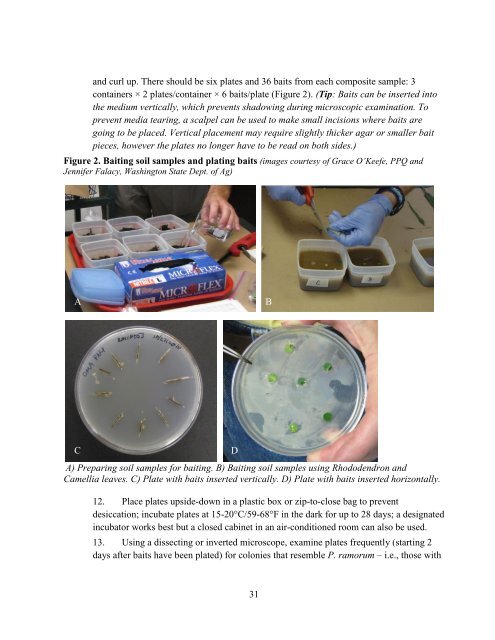Confirmed Nursery Protocol - aphis
Confirmed Nursery Protocol - aphis
Confirmed Nursery Protocol - aphis
Create successful ePaper yourself
Turn your PDF publications into a flip-book with our unique Google optimized e-Paper software.
and curl up. There should be six plates and 36 baits from each composite sample: 3<br />
containers × 2 plates/container × 6 baits/plate (Figure 2). (Tip: Baits can be inserted into<br />
the medium vertically, which prevents shadowing during microscopic examination. To<br />
prevent media tearing, a scalpel can be used to make small incisions where baits are<br />
going to be placed. Vertical placement may require slightly thicker agar or smaller bait<br />
pieces, however the plates no longer have to be read on both sides.)<br />
Figure 2. Baiting soil samples and plating baits (images courtesy of Grace O’Keefe, PPQ and<br />
Jennifer Falacy, Washington State Dept. of Ag)<br />
A<br />
B<br />
C<br />
D<br />
A) Preparing soil samples for baiting. B) Baiting soil samples using Rhododendron and<br />
Camellia leaves. C) Plate with baits inserted vertically. D) Plate with baits inserted horizontally.<br />
12. Place plates upside-down in a plastic box or zip-to-close bag to prevent<br />
desiccation; incubate plates at 15-20°C/59-68°F in the dark for up to 28 days; a designated<br />
incubator works best but a closed cabinet in an air-conditioned room can also be used.<br />
13. Using a dissecting or inverted microscope, examine plates frequently (starting 2<br />
days after baits have been plated) for colonies that resemble P. ramorum – i.e., those with<br />
31
















